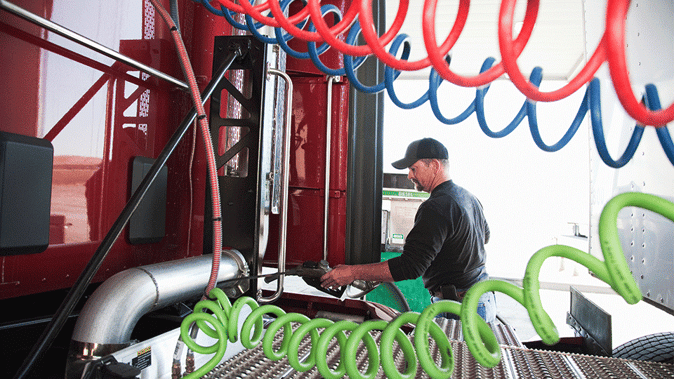
The U.S. Energy Information Administration (EIA) is a government agency that collects, analyzes and reports energy information to policymakers and the public.
Each week, the EIA releases data reflecting the current U.S. distillate fuel oil stock levels. Distillate fuel oil is used to power many internal combustion vehicles (both mechanical and electric), heaters and generators making it an essential global commodity.
In late October 2022, the EIA updated its distillate fuel oil data chart — containing data collected every year since 1982 — with October’s end-of-month numbers.
As of October 28, distillate fuel oil stock levels in the U.S. were reported at their lowest level to end a month since April 2008. These stocks, which typically hover between 115,000-150,000 (on a scale where 1 equals 1,000 barrels of fuel), exited October at 106,784. Similarly, on April 25, 2008, 105,831 was reported.
This has caused a ripple of commotion around our nation, with some fearing significant diesel-fuel scarcity is on the horizon.
Here are the numbers driving this concern:
- Currently, the U.S. uses around 4.2 million barrels of diesel per day.
- It’s reported that 106.7 million barrels of distillate fuel oil sit in national reserves.
- Barring any output from U.S. oil refineries or international trade, the U.S. has 25 remaining days of diesel supply.
The Anderson Family of Companies operates more than 2,600 semi-trucks. Together, these trucks rely on thousands of gallons of diesel every day. While national reserves are at their lowest levels since 2008, we’re not panicking and neither should you.
On the surface, 25 days of remaining diesel supply might fill you with uncertainty.
That said, in this article, we’ll break down what’s happening with U.S. diesel supply to help you ensure the success of your transportation supply chain going forward.
Below you’ll find an explanation of:
- How the demand for diesel changes in the fall
- The current constraints facing the U.S. diesel supply chain
- What rising fuel prices mean for freight transportation and tips for planning
How the Demand for Diesel Fuel Changes in the Fall
Starting in late August and carrying through November, diesel consumption rises across the U.S.
This occurs every year as three things happen:
- Harvest season around the nation significantly increases the amount of diesel used by the agriculture sector
- The volume of freight moving increases as consumer spending peaks headed into the holidays
- Colder weather spurs the purchase of heating oil (a product of distillate fuel) to heat homes in some areas
Together, these three changes reliably inflate the overall consumption of diesel in our country during the fall months. In turn, the EIA regularly reports lower fuel reserves during the fall than in the summer and winter.
This is partially what we’re experiencing right now. As harvest season wages on in various regions, temperatures fall and durable goods purchases increase during retail peak, diesel consumption predictably rises. That said, this year there are two other constraints to note.
2 Constraints Facing the U.S. Diesel Supply Chain
The U.S. has a finely-tuned process for managing its crude oil acquisition, refinement and distribution. Here’s a basic overview of this process:
- Crude oil is acquired — either through offshore trade or domestic mining and production
- This crude oil is transported to a U.S. refinery for distillation
- Distillate diesel fuel is placed into refinery storage (where the EIA is collecting its data)
- Diesel fuel is transported via barge, pipeline or truck to various facilities and terminals within high-consumption areas
- Diesel fuel is transported by tanker truck to retail locations (gas stations)
The EIA reports that in 2021, the U.S. produced nearly 68.5 billion gallons of distillate diesel fuel, outpacing consumption during that same period. In a healthy economy, these production levels are enough to support U.S. demands for diesel fuel while simultaneously building up diesel reserves and allowing for the sale of excess fuel to other nations.
Through a combination of circumstances, however, two parts of this supply chain have been impacted this year. These are:
- The acquisition of crude oil from other countries
- The pace of distillate fuel oil refinement
1. The Acquisition of Crude Oil From Other Countries
The U.S. imports the vast majority of its crude oil from Canada and Mexico. According to the EIA, more than 70 percent of U.S. crude oil imports in 2021 came from our North American neighbors.
That said, historically our country has also received crude oil from Russia — importing more than 200,000 barrels per day in 2021. In a typical year, the U.S. will import 3-5 percent of its total crude oil imports directly from Russia. This year, however, global conflicts have disrupted this relationship, leaving our nation with fewer crude oil imports to rely on.

While the U.S. is not dependent on Russia as a source of crude oil, historically it produces around eight percent of the global crude oil supply. As a result, many nations have had to look elsewhere to fill this void in 2022, complicating this process further.
2. The Pace of Distillate Fuel Oil Refinement
As of right now, the U.S. has 125 oil refineries currently in operation. Over the past five years, the volume of operable refineries in our country has gone down as a result of scheduled maintenance, a few major fires and the COVID-19 pandemic.
Because of this, the rate at which our country can produce distillate diesel fuel has faltered slightly; in 2019 (with 132 refineries) the U.S. produced 4,580,230 barrels per stream day and in 2022 we’re on pace for 4,307,200.
With a slower pace of refinement, the U.S. has had slightly more trouble building up its stores as quickly as in years past.
What Should You Expect Going Forward?
As we continue into 2023, it’s not time to panic. The U.S. will not run out of diesel — at least not the way things are going.
Instead, if it’s necessary, expect oil refineries to begin producing more diesel per barrel than gasoline. The percentage of crude oil used to create each of these products can be adjusted according to demand trends. This is what we anticipate happening in the months ahead.
Additionally, as with any other constraint we’ve faced, we anticipate the U.S. distillate fuel oil supply chain to re-optimize to its current challenges. Should this mean higher-than-average diesel prices for the foreseeable future, you’ll want to prepare for this reality.
What Rising Fuel Prices Mean for Freight Transportation and What You Can Do
Purchasing diesel fuel is one of the largest expenses associated with running a trucking company and hauling freight. Like equipment replacement/maintenance costs and insurance premiums, fuel prices are out of every carrier’s control and unavoidable.
There is nothing — short of leaving the industry — trucking companies can do to avoid fuel expenses. As they rise, trucking companies (and their drivers) are forced to increase the rates they charge customers.
For this reason, should fuel prices rise in the coming weeks and months, expect your freight rates to increase. Often, from a carrier’s perspective, it’s important to pass through fuel expenses to the price of their service. Although there are multiple ways to manage your fuel surcharges, expect your all-in freight expenses to increase when diesel prices rise.

Rising fuel prices, although unavoidable, don’t need to wreck your transportation budget. Pay attention to these changes and control the things you can.
For a few additional tips for managing your transportation supply chain when diesel prices are volatile, check out this article which covers How Rising Fuel Prices Affect Transportation (+ 3 Budgeting Tips).
Finally, to help you keep your supply chain running efficiently in the year ahead, ATS is proud to offer a monthly newsletter full of relevant tools and helpful insights.
Subscribe to our market-update newsletter here and make sound, informed logistics decisions — regardless of what next year throws your way.



